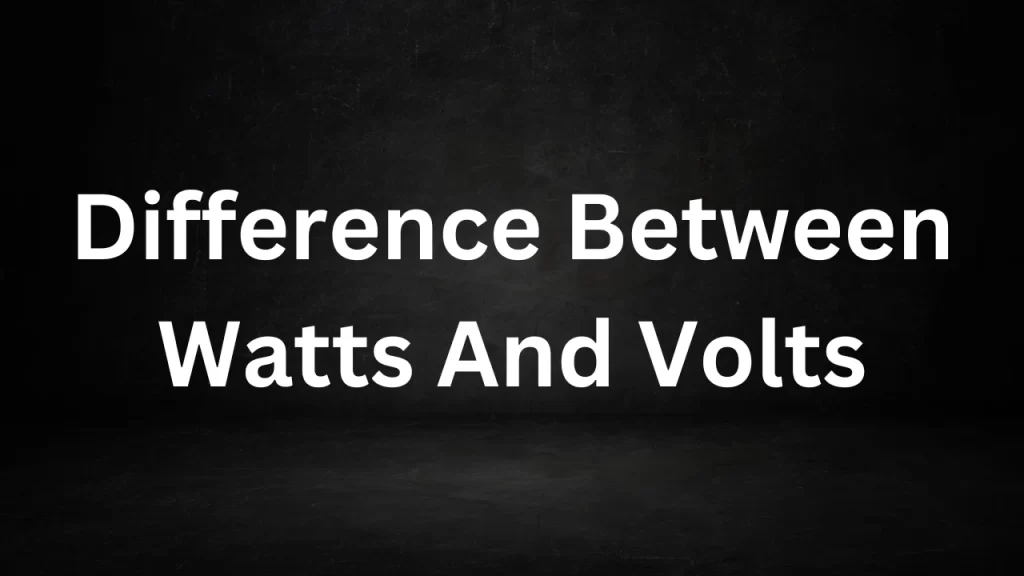Tag: Difference Between Watts And Volts
Difference Between Watts And Volts
Difference Between Watts And Volts: Understanding the Difference Between Watts and Volts

Watts And Volts
Introduction
In the realm of electricity and power, two fundamental concepts that often lead to confusion are watts and volts. While they both play critical roles in the world of electrical systems, they represent different aspects of electricity. This article aims to clarify the distinctions between watts and volts, helping you better comprehend their significance and practical applications.
Watts (W) – The Measure of Power
Watts, denoted by the symbol ‘W,’ are the units used to measure power in an electrical circuit. Power is essentially the rate at which energy is transferred, converted, or used. In simpler terms, it tells us how quickly work is being done in an electrical system. The relationship between watts, voltage (volts), and current (amperes) is described by the formula:
In this equation:
- P represents power in watts.
- V represents voltage in volts.
- I represents current in amperes.
In practical terms, watts are a measure of how much energy is consumed or produced per unit of time. For instance, a 100-watt light bulb consumes 100 watts of electrical power while it’s illuminated. Similarly, a 1,000-watt (1 kilowatt) space heater consumes 1 kilowatt-hour of energy in one hour.
Volts (V) – The Measure of Electrical Potential
Volts, denoted by the symbol ‘V,’ represent electrical potential or voltage. Voltage is a measure of the electric potential energy per unit charge at a given point in an electrical circuit. In simpler terms, it tells us the force that drives electric charge through a conductor. A higher voltage means that electrons have more potential energy and will move with more force through the circuit.
Voltage is often compared to water pressure in a plumbing system. Just as higher water pressure causes water to flow more forcefully through pipes, higher voltage causes electric current to flow more forcefully through wires.
Practical Examples
To better understand the difference between watts and volts, consider the following examples:
- Light Bulb: A 100-watt light bulb requires 100 watts of power to produce light. However, it operates at a standard household voltage of 120 volts in the United States. To calculate the current flowing through it, you can use the formula I = P / V, which in this case is I = 100W / 120V ≈ 0.83 amperes.
- Battery: A common AA battery typically supplies 1.5 volts. The voltage represents the potential difference between the battery’s positive and negative terminals, which drives the flow of electric current. The power (in watts) the battery can deliver depends on the device it’s connected to and the current it draws.
- Electric Kettle: A 1,500-watt electric kettle heats water quickly. When you plug it into a standard 120-volt outlet, it draws approximately 12.5 amperes of current to produce that 1,500 watts of power, creating the heat needed to boil water.
Conclusion
In summary, watts and volts are distinct but interrelated concepts in the world of electricity. Watts measure power, which is the rate of energy transfer or consumption, while volts measure voltage, which is the electrical potential that drives the flow of electric current.
Understanding these differences is crucial for effectively managing and using electrical systems, from household appliances to industrial machinery. Whether you’re troubleshooting electrical issues at home or designing complex electrical circuits, a clear grasp of the distinction between watts and volts is essential for safe and efficient operation.
Read More
- Molar Mass Of Sulphur
- Electronics In Daily Life
- Molecular Weight Of Hcl
- Asteroid And Comet Difference
- Molecular Weight Of Nitrogen
Frequently Asked Questions (FAQs) Watts And Volts
What is the fundamental difference between watts and volts?
Watts measure power, which is the rate of energy transfer or consumption, while volts measure voltage, which is the electrical potential that drives the flow of electric current.
What do watts and volts represent in electrical terms?
Watts represent the amount of work done or the rate of energy transfer in an electrical circuit. Volts represent the electrical potential difference that drives the flow of electric charge.
How are watts and volts related in an electrical circuit?
Watts can be calculated by multiplying volts by amperes (W = V × I), where (V) represent the voltage and amperes (I) represent the current.
Can you provide a practical example illustrating the difference between W and V ?
Sure, consider a 100-W light bulb. The 100 watts (W) represent the power it consumes to produce light, while the standard household voltage of 120 V provides the electrical potential needed for the bulb to function.
What happens if you increase the voltage while keeping the wattage constant in an electrical circuit?
Increasing the voltage while keeping the wattage constant will result in an increase in the current (amperes). This can lead to higher power consumption and may affect the operation of electrical devices.